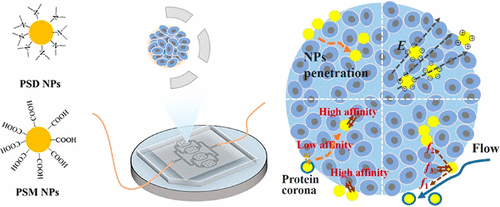当前位置:
X-MOL 学术
›
Mol. Pharmaceutics
›
论文详情
Our official English website, www.x-mol.net, welcomes your feedback! (Note: you will need to create a separate account there.)
Nanoparticles Penetrate into the Multicellular Spheroid-on-Chip: Effect of Surface Charge, Protein Corona, and Exterior Flow
Molecular Pharmaceutics ( IF 4.9 ) Pub Date : 2017-11-13 00:00:00 , DOI: 10.1021/acs.molpharmaceut.7b00726 Ke Huang 1 , Rena Boerhan 1 , Changming Liu 1 , Guoqiang Jiang 1
Molecular Pharmaceutics ( IF 4.9 ) Pub Date : 2017-11-13 00:00:00 , DOI: 10.1021/acs.molpharmaceut.7b00726 Ke Huang 1 , Rena Boerhan 1 , Changming Liu 1 , Guoqiang Jiang 1
Affiliation

|
Nanoparticles (NPs) are widely studied as tumor targeted vehicles. The penetration of NPs into the tumor is considered as a major barrier for delivery of NPs into tumor cell and a big challenge to translate NPs from lab to the clinic. The objective of this study is to know how the surface charge of NPs, the protein corona surrounding the NPs, and the fluid flow around the tumor surface affect the penetration and accumulation of NPs into the tumor, through in vitro penetration study based on a spheroid-on-chip system. Surface decorated polystyrene (PS) NPs (100 nm) carrying positive and negative surface charge were loaded to the multicellular spheroids under static and flow conditions, in the presence or absence of serum proteins. NP penetration was investigated by confocal laser microscopy scanning followed with quantitative image analysis. The results reveal that negatively charged NPs are attached more on the spheroid surface and easier to penetrate into the spheroids. Protein corona, which is formed surrounding the NPs in the presence of serum protein, changes the surface properties of the NPs, weakens the NP–cell affinity, and, therefore, results in lower NP concentration on the spheroid surface but might facilitate deeper penetration. The exterior fluid flow enhances the interstitial flow into the spheroid, which benefits the penetration but also strips the NPs (especially the NPs with protein corona) on the spheroid surface, which decreases the penetration flux significantly. The maximal penetration was obtained by applying negatively charged NPs without protein corona under the flow condition. We hope the present study will help to understand the spatiotemporal performance of drug delivery NPs and inform the rational design of NPs with highly defined drug accumulation localized at a target site.
中文翻译:

纳米粒子渗透到芯片上的多细胞球体:表面电荷,蛋白电晕和外部流动的影响。
纳米颗粒(NPs)被广泛研究为靶向肿瘤的载体。NPs进入肿瘤被认为是NPs进入肿瘤细胞的主要障碍,也是将NPs从实验室转化为临床的一大挑战。这项研究的目的是通过基于球体的体外渗透研究,了解NP的表面电荷,NP周围的蛋白电晕以及肿瘤表面周围的流体流动如何影响NP的渗透和积累。芯片系统。在存在或不存在血清蛋白的情况下,在静态和流动条件下,将带有正负表面电荷的表面修饰的聚苯乙烯(PS)NP(100 nm)加载到多细胞球体上。通过共聚焦激光显微镜扫描和定量图像分析研究了NP渗透。结果表明,带负电荷的NP附着在球体表面上的数量更多,并且更容易渗透到球体中。在血清蛋白存在下围绕NPs形成的蛋白质电晕会改变NPs的表面性质,削弱NP-细胞亲和力,因此导致球体表面上的NP浓度降低,但可能有助于更深的渗透。外部流体流动增强了进入球体的间隙流量,这有利于渗透,但也会剥夺球体表面上的NP(尤其是带有蛋白质电晕的NP),从而大大降低了渗透通量。通过在流动条件下施加不带蛋白质电晕的带负电荷的NP,可以获得最大的穿透力。
更新日期:2017-11-13
中文翻译:

纳米粒子渗透到芯片上的多细胞球体:表面电荷,蛋白电晕和外部流动的影响。
纳米颗粒(NPs)被广泛研究为靶向肿瘤的载体。NPs进入肿瘤被认为是NPs进入肿瘤细胞的主要障碍,也是将NPs从实验室转化为临床的一大挑战。这项研究的目的是通过基于球体的体外渗透研究,了解NP的表面电荷,NP周围的蛋白电晕以及肿瘤表面周围的流体流动如何影响NP的渗透和积累。芯片系统。在存在或不存在血清蛋白的情况下,在静态和流动条件下,将带有正负表面电荷的表面修饰的聚苯乙烯(PS)NP(100 nm)加载到多细胞球体上。通过共聚焦激光显微镜扫描和定量图像分析研究了NP渗透。结果表明,带负电荷的NP附着在球体表面上的数量更多,并且更容易渗透到球体中。在血清蛋白存在下围绕NPs形成的蛋白质电晕会改变NPs的表面性质,削弱NP-细胞亲和力,因此导致球体表面上的NP浓度降低,但可能有助于更深的渗透。外部流体流动增强了进入球体的间隙流量,这有利于渗透,但也会剥夺球体表面上的NP(尤其是带有蛋白质电晕的NP),从而大大降低了渗透通量。通过在流动条件下施加不带蛋白质电晕的带负电荷的NP,可以获得最大的穿透力。



























 京公网安备 11010802027423号
京公网安备 11010802027423号